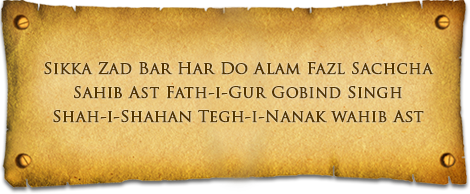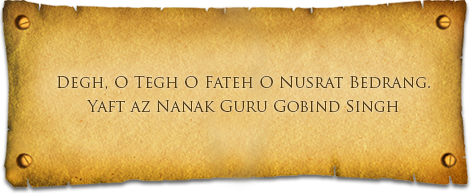KHALSA CURRENCY AND STAMPS
Baba Banda Singh Bahadur issued a new coin, a symbol of sovereignty, in the name of the Sikh Guru Sahibans. After becoming ruler from Delhi to Lahore, he issued Coins on the name of the Sikh Guru Sahibans. By doing this he became the only ruler of the world to do so. The dream of Guru Nanak in context of ideal rule was executed by Baba Banda Singh Bahadur.
“Nanak raj chalaya sach kot satani neen dai”
Guru Granth Sahib Ang :966

ON THE REVERSE WAS THE INSCRIPTION:
On the Reverse inscription of the Sikh coin Baba Banda Singh Bahadur wrote the Lohgarh as Khalsa –Takht.
Zarb Khalsa Mubarak Bakht, Ba- Aman Ud-Dahr, Zinat At- Takht, Mashwarat Shahr
{Meaning: coined at model city, the refuge of the world, the ornament of the Fortunate Khalsa throne}. These were the titles and epithets used by Baba Banda Singh Bahadur for Lohgarh. Now these two words become more interested in research as Khalsa-Takht is the seat of power in Sikhism. Guru Hargobind Sahib revealed Akal Takht and after that Baba Banda Singh Bahadur (nominee of Guru Gobind Singh) declared Lohgarh as Khalsa Takht and encrypted it in on the first coin of Khalsa Raj. Baba Banda Singh Bahadur calls Lohgarh a beautiful city, now the question is ‘where is Khalsa- Takht, the beautiful city (model City) and Khalsa Raj Capital.

(By the blessings of Guru Nanak and Guru Gobind Singh achieved the victory over the enemy and Started ever giving, charity for the poor)
This had reference to the two strongest symbols of the sikh gurdwara symbols that had proved to be the most powerful source of the sikhs popularity Power. The ‘degh’ was the cauldron in which the food for the gurus’ langar was cooked. It became at once the symbol for the attempt by the Sikh religion to abolish the caste system : all followers of the gurus, irrespective of cast or creed ate collectively from the food cooked in the cauldron. The ‘degh’ was also the symbol of charity, the means used to feed the poor. The ‘tegh’ was the sword, the symbol of the power and might of the ‘Khalsa’. It was the symbol of their war against the oppressors and their tyranny, a symbol of the protection offered to the weak and the helpless. The third measure that Banda adopted was the introduction of his own calendar, his era, beginning from this victory of Sirhind.
In the adoption of these three measures – the striking of new coinage, the use of his own seal and the adoption of a new calendar – Banda was doing no more than what each new ruler did on gaining power. Through these three measures the ruler emphasized not only his own individual strength as distinct from the strength of his predecessors, but also sought to show that he was a totally independent ruler, not subservient to any other ruler of the time. By striking the coins and the seal in the name of his gurus, Nanak and Gobind, Banda sought to silence any criticism of imperial design. He claimed through these measures that the gurus were his guardian angels and all his power and prosperity was a boon from the gurus and had nothing to do with his individual achievements. But in the months to come, the new coinage and the use of the seal came to be associated with imperial might and it was clear as daylight that this might have emanated from the personality at the centre. No matter how earnestly Banda eschewed the use of the word ‘king’, he had in every sense, except in name become a king.



















